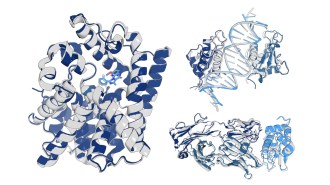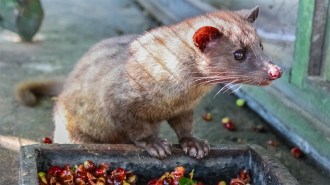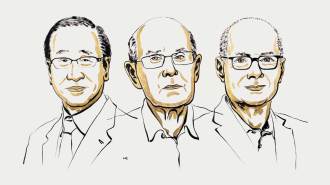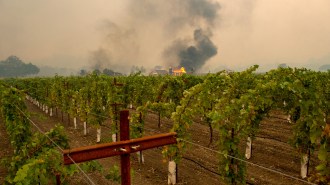- More than 2 years ago





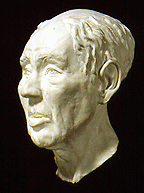


“Pan scrapings!” announced G. Kenneth Sams. “When you come down to it, that is what has brought us all here tonight—pan scrapings.”
It was probably not the most appetizing introduction for a $150-per-plate museum fundraiser. Some 150 guests, many in black tie, had just sat down to enjoy their first course at lavish banquet tables in the Upper Egyptian Gallery of the University of Pennsylvania Museum of Archaeology and Anthropology in Philadelphia. Did they really want to consider dirty dishes as they sipped wine and sampled the Turkish meze before them?
Well, yes. After all, these weren’t just any old dishes left in the sink overnight. Sams, of the University of North Carolina at Chapel Hill, and the project director for the Gordion archeological site in central Turkey, was telling the attendees about the vessels from which mourners ate an elaborate feast during King Midas’ funeral 2,700 years ago.
That wasn’t all. The modern diners sitting before Sams were about to eat the first reconstruction of that feast—a celebration that had remained undiscovered for decades after archaeologist Rodney S. Young first excavated Midas’ tomb in 1957.
Ancient Roman, Greek, or even Maya banquets had been re-created previously, but generally from texts and ancient recipes. Not so with the Midas feast. “It’s the first time that somebody tried to do it working just from the chemical evidence,” says Patrick E. McGovern, the museum’s molecular archaeologist who led the analyses. In other words, from the pan scrapings.
Greedy king
According to Greek myth, a foolish King Midas requested his famed golden touch from the god Dionysus. Soon after Dionysus granted his wish, however, Midas found that even his food became gold, and he faced starvation. Fortunately for Midas, Dionysus permitted the greedy king to return to his old self once he bathed in the river Pactolus.
Archaeologists and historians know that the real king Midas was a powerful leader around 700 B.C. in Phrygia, a region in what is now central Turkey. When Young discovered and excavated what is almost certainly Midas’ tomb at Gordion in 1957, he found that it held no gold but plenty of evidence of a royal and wealthy man.
Yet even more treasure lay unrecognized near Midas’ remains. Perhaps in Young’s rush to finish his work before grave robbers could intercede, he misinterpreted some of the tomb’s contents. He didn’t realize that the vessels and wooden furniture he had found had been used by mourners for a funerary feast outside the tomb and then stashed in it.
More than 20 years later, archaeologist Elizabeth Simpson found that the telltale clue to an outdoor feast had been lying right under Midas himself.
While Simpson was drawing pictures of Young’s excavation finds for a posthumous book on his research in 1978, she realized that something was amiss. She was recreating the structure of a deteriorated four-poster bed that Young had said the king’s skeleton lay upon when the excavation team opened the tomb. But Simpson couldn’t work out a satisfactory arrangement of a bed’s pieces from the original tomb photos.
She went to Turkey in 1981 and eventually turned up the so-called four-poster in a storage area at the Gordion site. It was not a bed, it turned out, but a hollowed-out log coffin that could have served as a bier for displaying the king’s body. “And then, the light went on,” she says.
Simpson determined that four supports, which Young had thought to hold the bedposts, actually had steadied the coffin for display. However, these pieces of wood weren’t in their supporting locations when Young opened the tomb. “That was how I figured out there was a ceremony outside,” says Simpson. If the king wasn’t properly on display in the tomb, he must have previously been on display somewhere else.
It took Simpson the next 10 years to work out the details. She eventually determined that mourners had held a ceremonial banquet outside the tomb. All the while, amid the scene, Midas’ body lay in state on his bier.
After the mourners had their fill of food and alcohol, they lowered Midas’ body into the tomb, along with their party leftovers. Simpson’s theory was supported by other tomb contents, including furniture such as banquet tables and the best collection of Iron Age drinking vessels ever uncovered. Yet she became frustrated in her attempt to more completely reconstruct the event. She needed to understand what the ancient Phrygians had served in the vessels.
Simpson knew that Young’s 1957 research team had removed dry yellow powder and some brown residue from the tomb vessels and dumped the samples into bags. The excavators had then shipped the bags off to storage in the University of Pennsylvania Museum’s Gordion archives. Yet Simpson couldn’t find anyone who could tell her what those residues had looked or tasted like 2,700 years ago.
Helping hand
Then in 1997, Simpson asked McGovern to help out. McGovern had by that time used modern chemical techniques to analyze the remnants of the earliest wine and the earliest beer yet found (SN: 6/8/96, p. 359). Simpson, who now leads the Gordion Furniture Project and is a professor at the Bard Graduate Center for Studies in the Decorative Arts in New York City, located and labeled the samples in the Penn archive and turned them over to McGovern.
McGovern had an extraordinary amount of ancient material to work with—5 pounds of food residue and about a pound of beverage remains. Most of the tests that he and his colleagues wanted to perform require just a milligram, or even a microgram, of material.
“We have an embarrassment of riches here for molecular archaeologists,” he says. “The real gold was inside these vessels, and that was the ancient material that we analyzed.”
Through a battery of tests—liquid and gas chromatography and mass spectrometry, for example—McGovern and his colleagues pinned down the signature compounds in the residues that would tell them what the mourners had eaten and drunk. That allowed the scientists to attempt to reconstruct recipes, he says.
Analyses of the brown food leftovers showed specific fatty acids and a lot of cholesterol, indicative of goat or lamb meat, says McGovern. Presence of polycyclic aromatic hydrocarbons indicated that the meat was barbecued. A plant steroid was the fingerprint for lentils, he says, and anisic acid indicated that the food preparers had spiced this dish with anise or fennel. Elaidic acid pointed to the use of olive oil, as well.
The Phrygians must have cut the meat off the bone to create a stew, since the tomb excavation uncovered no bones.
The beverage’s yellow, powdery residue revealed an unusual combination of honey mead, wine, and beer. The researchers recognized remains of honey mead when they discovered substances related to beeswax. They also found calcium oxalate, so-called beerstone, which is produced during barley beer brewing, and they identified tartaric acid, which appears in grapes and therefore wine. Whether the three types of beverages were brewed together or made separately and then combined, the researchers couldn’t determine. They published their results in the Dec. 23/30, 1999 Nature.
Sometime during all this research, someone decided it would be fun—and educational—for the scientists to actually taste the fruits of their labor. The researchers can’t remember exactly who suggested it or when, but they eventually decided to attempt a reconstruction of the ancient food and brew served at Midas’ funeral.
For those tasks, McGovern approached a chef and a brewmaster.
Menu planning
Chef Pamela Horowitz of Museum Catering Company in Philadelphia started working on the banquet menu months before the event. Horowitz reconstructed the lamb-and-lentil stew and then used her imagination to prepare Turkish appetizers and dessert.
“It’s been a really great process to figure out how we want to present foods that were found to be in the tomb 2,700 years ago, which are still available in the region, and how to formulate a meal without recipes,” says Horowitz.
Almost all of the foods on her menu would have been found in Phrygia, with one major exception, she says. Since chocolate is a New World food, Phrygians probably didn’t eat a gold-laced chocolate truffle, which to please modern museum patrons accompanied Horowitz’ favorite part of the meal—a honey-caramelized fennel dessert tart.
Moving on to the drink menu, McGovern says, “I was especially interested in trying to recreate the fermented beverage.” He also wanted “to answer questions about whether it’s even possible to brew these three things together and what combinations of different ingredients work well,” he adds. McGovern assigned the challenge to microbrewer Sam Calagione of Dogfish Head Craft Brewery in Lewes, Del.
“We’ve gotten a reputation for brewing sort of esoteric beers,” says Calagione.
Although the chemical analysis had revealed the basic ingredients, much remained unknown about how to create the so-called King Midas Golden Elixir. Calagione had to make educated guesses and see if his instincts resulted in something palatable.
For example, Calagione kept his brew at room temperature, reasoning that the ancient Phrygians didn’t have refrigeration.
He also decided to combine all three parts—the honey mead, the beer, and the wine—before fermentation. He targeted an alcohol content of 7.5 percent, midway between beer and wine, and an amount of carbonation also halfway between the two.
The researchers suspected that some spice was present but couldn’t identify it. Calagione decided to add saffron, which would have grown in Phrygia. He didn’t know how much to include. “So, I added exactly four handfuls,” about a pound, of saffron to make the six kegs of brewed beverage, he says.
McGovern says he’d like to work with Calagione to eventually market the drink. It would cost about $75 per case to bottle and sell, Calagione estimates.
“It has more of the refinement and mellowness of a wine than the robustness of an ale,” Calagione says.
Dinner is served
Finally, in late September, the University of Pennsylvania Museum hosted the affair.
“Here we are tonight, feeding on spicy lamb and lentils, just as those who saw off Midas did,” Sams told the guests as servers brought in the main course.
The stew was the hit of the evening.
“It’s the best lamb stew I’ve had in a long time,” said guest Albert T. Olenzak, a financial consultant and former engineer from the Philadelphia area.
Banquet attendee Robert A. Moreau, who has a particular connection to the stew, agreed. He and his colleague Alberto Nuñez, both of the Department of Agriculture’s Eastern Regional Research Center in Wyndmoor, Pa., had analyzed the fats in the ancient food samples.
As diners finished the entrée, McGovern rose to speak. “After you’ve had such a fine stew, what do you wash it down with?” he asked the guests, while dessert and the sparkling yellow King Midas Golden Elixir appeared before them on the royal-purple tablecloths.
“It was delicious,” says Simpson, who knows perhaps more about the meal’s long history than anyone else. “I was so thrilled to be eating and drinking [the stew and elixir] after working on this project for such a long time.”


